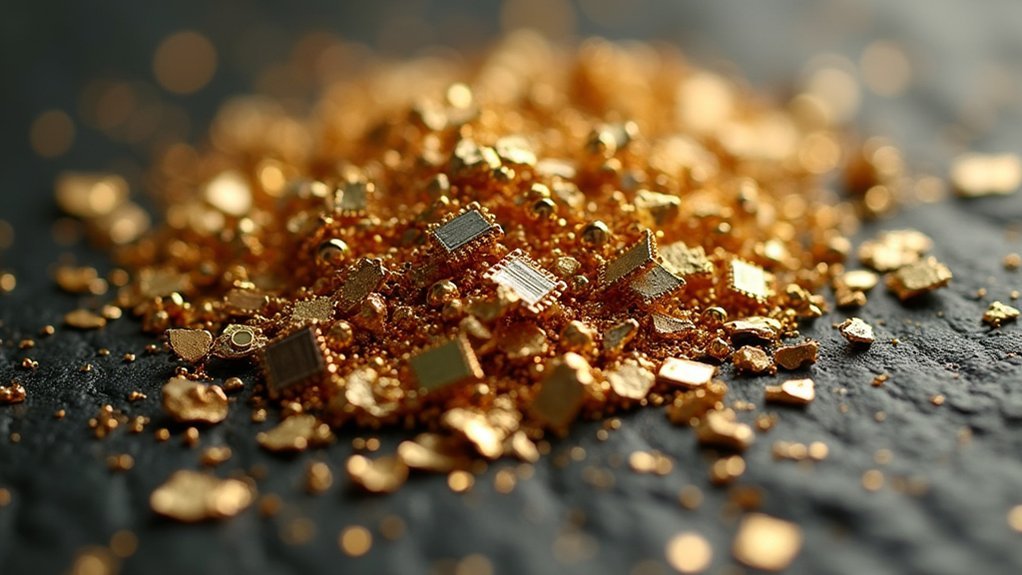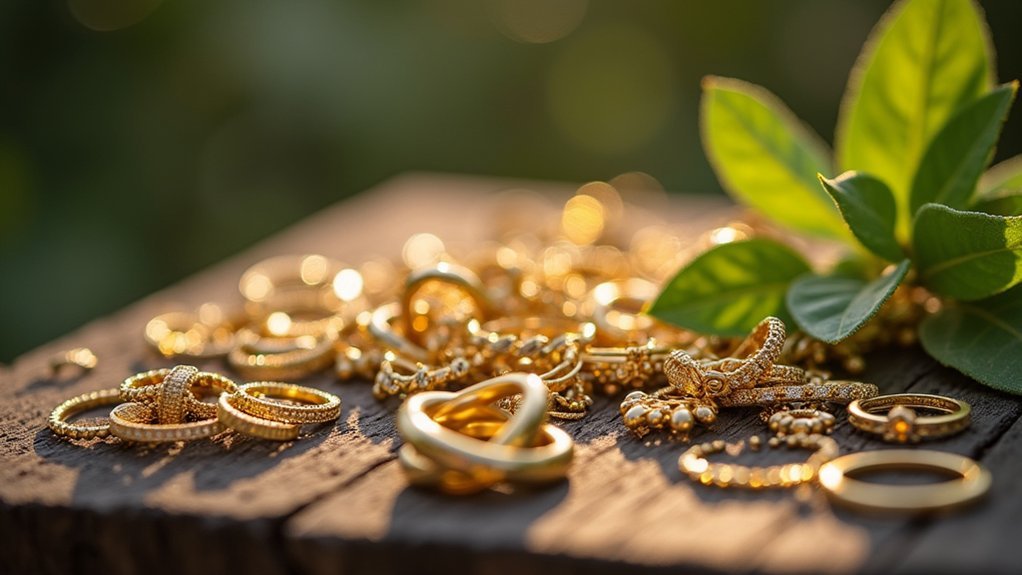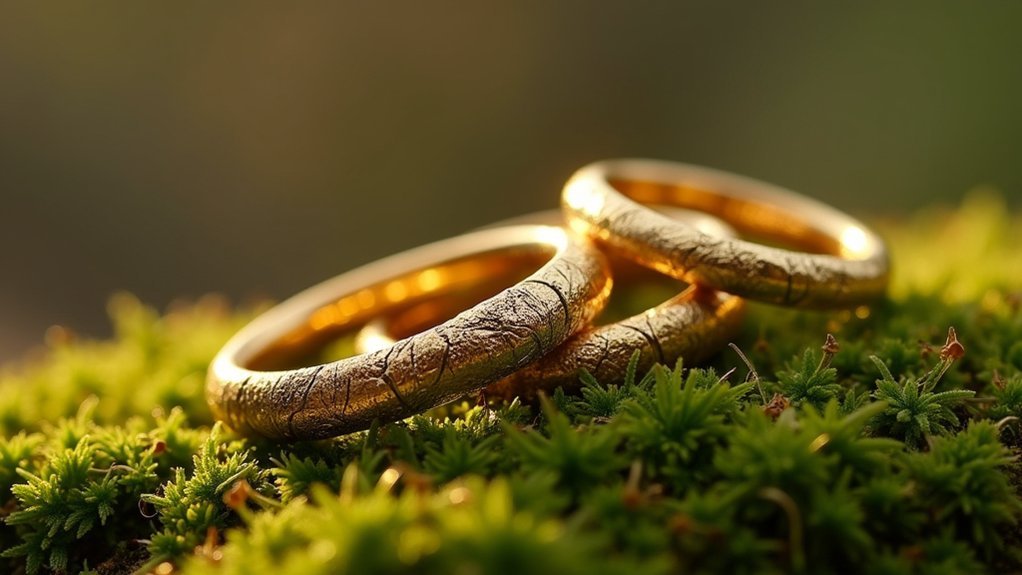You can considerably reduce environmental destruction by choosing recycled gold jewelry, which uses 90% less energy than traditional mining and eliminates toxic chemicals like cyanide and mercury from the process. Recycled gold maintains identical quality to newly mined gold, achieving up to 99.99% purity while preventing massive habitat destruction since traditional mining requires excavating 20 tons of earth per ounce. This sustainable approach supports circular economy principles and ethical sourcing standards that’ll transform your understanding of responsible jewelry purchasing.
Understanding the Environmental Impact of Traditional Gold Mining

While that gold wedding ring on your finger weighs just a few grams, its creation likely required extracting up to 20 tons of earth, leaving behind a trail of environmental destruction that extends far beyond what you’d imagine.
The environmental impact of traditional gold mining devastates ecosystems through massive habitat destruction and biodiversity loss. You’re also dealing with cyanide leaching processes that contaminate soil and water sources while contributing to mercury pollution.
Mining operations destabilize landscapes, causing deadly landslides in vulnerable communities. Over 200 tailings dam collapses have released toxic byproducts into ecosystems worldwide.
Workers, including children, face dangerous conditions and exploitation. Understanding these harsh realities makes sustainable practices essential for responsible jewelry consumption.
The True Cost of New Gold Extraction on Ecosystems
Beyond the surface-level destruction lies a deeper ecological catastrophe that ripples through interconnected natural systems for decades.
You’re witnessing environmental harm on an unprecedented scale when gold mining operations contaminate waterways with mercury, poisoning aquatic life and disrupting food chains.
Gold mining’s mercury contamination creates a toxic cascade that devastates aquatic ecosystems and poisons wildlife for generations.
The cyanide leaching process doesn’t just extract precious metals—it transforms thriving ecosystems into toxic wastelands where nothing can survive.
- Mercury pollution spreads through water systems, bioaccumulating in fish and wildlife
- Tailings dam failures release concentrated toxins across vast landscapes instantly
- Landscape destabilization triggers landslides that destroy habitats permanently
You can’t ignore that traditional extraction methods sacrifice entire ecosystems for minimal gold yields.
Choosing ethical and sustainable alternatives protects these irreplaceable natural systems from further devastation.
How Recycled Gold Reduces Environmental Destruction

When you choose recycled gold for your jewelry, you’re actively preventing the catastrophic environmental destruction that traditional mining inflicts on our planet.
Traditional gold extraction devastates ecosystems through deforestation and soil degradation—requiring up to 20 tons of earth removal for a single wedding ring.
Recycled gold eliminates these environmental concerns by reusing existing materials instead of mining new ore.
You’re also avoiding harmful chemicals like cyanide and mercury that contaminate water sources during traditional mining operations.
The recycling process uses 90% less energy than extracting gold from ore, considerably reducing carbon emissions.
The Process of Transforming Old Gold Into New Jewelry
This transformation offers significant advantages over traditional mining:
- Eliminates habitat destruction and pollution from new extraction
- Reduces carbon footprint through decreased mining emissions
- Supports circular economy principles by conserving natural resources
Using recycled gold dramatically minimizes the environmental impact of jewelry production while creating pieces you’ll treasure.
Quality and Purity Standards for Recycled Precious Metals

Although recycled gold comes from previously used sources, it must meet the same rigorous quality and purity standards as newly mined precious metals.
You’ll find that recycled gold typically achieves a minimum of 14 karats (58.3% pure gold) for jewelry production. Through advanced refining processes, impurities are removed, reaching purity levels up to 99.99% (24 karat) gold.
Through sophisticated refining techniques, recycled gold achieves exceptional purity standards, ranging from 14-karat jewelry grade to pristine 24-karat quality.
You can trust that recycled gold retains identical physical and chemical properties to newly mined gold, making it indistinguishable in quality and appearance.
Certifications like Fairmined and Responsible Jewelry Council guarantee ethical sourcing and environmental compliance throughout recycling. Many brands provide transparency reports detailing their sourcing and refining processes, allowing you to verify both quality and purity standards while supporting sustainable practices.
Comparing Recycled Gold to Newly Mined Gold Properties
The fundamental properties of recycled gold mirror those of newly mined gold in every measurable way.
You’ll find that recycled gold maintains identical durability, purity, and value for your jewelry pieces. The physical and chemical characteristics remain unchanged through the recycling process, ensuring your investment retains its worth.
When you choose recycled gold, you’re accessing the same quality while dramatically reducing environmental impact.
This ethical gold alternative uses 90% less energy than mining operations and eliminates the toxic waste production that accompanies new extraction.
- Identical Performance: Recycled gold offers the same longevity and beauty as newly mined alternatives
- Superior Sustainability: Reduces energy consumption by up to 90% compared to traditional mining
- Zero Quality Compromise: Maintains all desirable properties including color, hardness, and corrosion resistance
Sourcing Recycled Gold From Electronics and Old Jewelry

You’ll find recycled gold through two primary channels: extracting it from discarded electronics like smartphones and computers, or collecting it from old jewelry pieces that customers no longer want.
Each source requires specific recovery processes and collection methods to efficiently extract the precious metal while maintaining quality standards.
You must verify that the recycled gold meets industry purity requirements before incorporating it into new jewelry designs.
Electronics Gold Recovery Process
When you consider that nearly 40% of the world’s gold supply sits inside discarded electronics, you’re looking at one of the most promising sources for sustainable gold recycling.
The recovery process starts with carefully dismantling devices to extract gold-containing components like circuit boards and connectors. You’ll then use chemical leaching or melting techniques to separate the recycled gold from other materials.
The results are impressive – recycling one million cell phones yields approximately 24 pounds of gold. This process dramatically reduces environmental impacts compared to traditional mining while conserving natural resources.
- Dismantling: Remove circuit boards, processors, and connectors containing gold deposits
- Chemical extraction: Use acid solutions to dissolve and separate gold from base metals
- Purification: Refine extracted gold to jewelry-grade purity standards
Old Jewelry Collection Methods
Beyond electronics, jewelry retailers and recycling centers have developed sophisticated collection networks to acquire old gold jewelry from consumers.
You’ll find these businesses actively sourcing recycled gold from broken necklaces, outdated rings, and unwanted bracelets through buyback programs and trade-in initiatives. When you participate in these old jewelry collection methods, you’re directly supporting sustainable practices that reduce environmental damage from traditional mining operations.
These collection systems involve melting down your existing gold items, creating a circular economy where precious metals continuously cycle through new products.
You’re helping companies lower their ecological footprint while conserving natural resources. Manufacturing scrap and industrial materials also contribute to this recycling stream, ensuring maximum recovery of valuable gold content from various sources beyond consumer jewelry pieces.
Quality Standards Verification
Recycled gold from electronics and old jewelry requires rigorous quality verification to meet industry standards and consumer expectations.
You’ll need to ascertain your recycled materials undergo thorough testing to confirm purity levels and remove contaminants. Circuit boards and connectors contain varying gold concentrations, so proper assaying determines the actual recoverable content.
When sourcing from old jewelry, verification processes authenticate the metal composition and identify any alloys present.
Certifications like Fairmined Gold provide ethical assurance that your recycled materials meet strict environmental and social standards. These quality standards protect both manufacturers and consumers while supporting sustainable practices.
- Purity testing confirms gold content percentages and identifies contaminants
- Certification programs guarantee ethical sourcing and responsible recycling practices
- Documentation tracking maintains chain of custody throughout the verification process
Energy Savings Through Precious Metal Recycling

When you choose recycled precious metals for your jewelry, you’re cutting energy consumption by up to 90% compared to mining new materials from ore.
This dramatic reduction directly translates to considerably lower carbon emissions—recycling gold produces only 1.5 tons of CO2 per kilogram versus the staggering 29 tons generated by traditional mining methods.
You’ll contribute to substantial environmental benefits while supporting an industry shift that can prevent over 58,000 tons of annual CO2 emissions.
Reduced Energy Requirements
Although traditional gold mining demands enormous amounts of energy to extract precious metals from ore, recycling gold requires approximately 90% less energy to produce the same quantity of usable material.
When you choose recycled gold for your jewelry, you’re supporting reduced energy requirements that greatly lower environmental impact. This dramatic energy reduction translates directly into decreased greenhouse gas emissions, with companies like Pandora avoiding approximately 58,000 tons of CO2 emissions annually through their commitment to sustainable options.
The recycling process leverages existing infrastructure and technology, making resource management more efficient throughout the production cycle.
By embracing these practices, you’re contributing to:
- Lower carbon footprint in jewelry manufacturing
- More efficient use of existing precious metal resources
- Support for circular economy principles that minimize new extraction
Carbon Footprint Reduction
Beyond the immediate energy savings, precious metal recycling creates a cascade of carbon footprint reductions that reshape the entire jewelry supply chain.
When you choose recycled gold, you’re preventing approximately 58,000 tons of CO2 emissions annually from entering the atmosphere. This dramatic reduction occurs because recycling eliminates energy-intensive mining operations that would otherwise extract new metals from ore.
Your decision to purchase recycled precious metals directly impacts the environmental footprint of jewelry manufacturing.
The carbon footprint shrinks considerably when producers source materials through recycling rather than traditional mining. Each ounce of recycled gold you select saves roughly 20 tons of earth from excavation, reducing the overall environmental impact.
This sustainable approach transforms jewelry production into a climate-conscious industry that actively contributes to emission reduction goals.
Certifications and Standards for Sustainable Gold
Several certification programs have emerged to help you identify truly sustainable gold for your jewelry purchases. These certifications guarantee you’re supporting responsible mining practices and ethical sourcing standards.
Certification programs ensure your jewelry purchases support responsible mining practices and verified ethical sourcing standards for sustainable gold.
Fairmined Gold and Fairtrade Gold certifications confirm that gold comes from mines meeting strict environmental and social requirements.
The Responsible Jewelry Council (RJC) establishes industry-wide sustainability standards, requiring members to source certified materials and maintain ethical business practices.
When you choose recycled gold with proper certifications, you’re avoiding approximately 20 tons of earth displacement and considerable water pollution per wedding ring.
These certified recycled materials maintain identical quality and value to newly mined gold.
- Fairmined/Fairtrade certifications verify adherence to rigorous environmental and social standards
- RJC membership guarantees sustainable sourcing of certified recycled materials
- Recycled gold certifications considerably reduce environmental impact without compromising quality
The Role of Jewelers in Promoting Metal Recycling
You’ll find that jewelers play an essential role in advancing metal recycling through adherence to industry certification standards and active consumer education.
When you choose brands that follow Responsible Jewelry Council guidelines, you’re supporting companies that’ve committed to certified recycled materials throughout their supply chains.
These jewelers don’t just source responsibly—they’re also educating you about the environmental benefits of recycled metals, helping drive demand for sustainable practices across the entire industry.
Industry Certification Standards
When you’re shopping for sustainable jewelry, industry certification standards serve as your roadmap to truly responsible pieces.
These certifications like Fairmined and Fairtrade guarantee that your gold and silver come from mines following strict environmental and social practices. The Responsible Jewelry Council sets sustainability benchmarks, requiring members to source certified recycled metals and implement ethical operations.
Leading brands demonstrate these standards’ impact:
- Brilliant Earth assures 93% of their precious metals are recycled
- Pandora’s commitment to 100% recycled silver and gold will avoid 58,000 tons of CO2 annually
- Mejuri emphasizes recycled gold and silver throughout their collections
These certification standards drive consumer trust and push more jewelers toward eco-friendly methods, making sustainable jewelry increasingly accessible and transparent.
Consumer Education Initiatives
Everyone benefits when jewelers take an active role in educating consumers about metal recycling’s environmental advantages.
You’ll find leading brands like Pandora and Mejuri pioneering consumer education by committing exclusively to recycled materials and highlighting sustainability in their messaging. When jewelers offer 100% recycled gold and silver options, they’re directly reducing new mining’s environmental impact while promoting sustainable practices.
You can expect educated jewelers to explain the recycling process and collaborate with metal recyclers to guarantee reliable supply chains.
These educational initiatives emphasize the circular economy’s importance, encouraging you to recycle old jewelry pieces. By choosing jewelers who prioritize consumer education about recycled gold, you’re supporting businesses that foster greater sustainability awareness throughout the jewelry industry.
Consumer Benefits of Choosing Recycled Gold Jewelry
While traditional gold mining devastates landscapes and generates massive waste, choosing recycled gold jewelry delivers immediate benefits that extend far beyond your personal style.
When you select recycled gold, you’re eliminating the environmental impact of mining operations that generate up to 20 tons of toxic waste per ring. Your purchase supports ethical practices within the jewelry industry while maintaining identical quality and durability to newly mined gold.
Key benefits you’ll enjoy:
- Significant carbon footprint reduction – Major brands like Pandora avoid 58,000 tons of CO2 emissions annually through recycling
- Financial value protection – Recycled gold retains full market value without property degradation
- Conservation support – You’re directly contributing to habitat preservation and resource conservation through circular economy principles
Supporting Circular Economy Principles in Jewelry Making
By choosing recycled gold jewelry, you’re actively participating in a circular economy that transforms waste into valuable resources while breaking the destructive cycle of continuous mining.
When you support jewelers using recycled gold, you’re promoting sustainable practices that require considerably less energy than processing new metals from ore. This approach diverts over 58,000 tons of CO2 emissions annually, as major brands like Pandora demonstrate with their commitment to 100% recycled materials.
The circular economy principle encourages brands to source certified recycled materials, minimizing waste while supporting ethical labor conditions in mining communities.
Your purchasing decisions drive demand for environmentally responsible practices, helping conserve natural resources and prevent habitat destruction that traditional mining causes.
Ethical Considerations Beyond Environmental Impact
When you purchase recycled gold jewelry, you’re addressing human rights violations that extend far beyond environmental concerns.
By choosing recycled gold, you’re directly reducing demand for newly mined gold that often exploits workers in dangerous conditions. Your decision supports ethical practices that protect the 100 million people working in the global jewelry industry, many in artisanal mining where exploitation runs rampant.
Recycled gold helps eliminate the need for mining operations that frequently use child labor and expose workers to health hazards.
When you prioritize fair labor standards, you’re encouraging brands to source from certified suppliers who guarantee worker protection.
- Support worker safety by reducing demand for exploitative mining operations
- Promote fair labor conditions through conscious purchasing decisions
- Drive industry-wide adoption of ethical practices and transparency standards
Future Trends in Sustainable Precious Metal Sourcing
As consumer demand for ethical sourcing intensifies, the precious metals industry is undergoing a revolutionary transformation that’ll reshape how jewelry reaches your hands.
You’ll witness major brands like Pandora achieving 100% recycled gold and silver usage by late 2024, setting new industry standards. The jewelry industry is rapidly embracing circular economy principles, where one ounce of recycled gold saves 20 tons of earth from extraction.
You’ll see increased collaboration between jewelers and metal recyclers, creating transparent supply chains that meet millennial and Gen Z expectations.
Silver recycling presents massive growth potential, with current rates below 20%. Sustainable sourcing isn’t just trending—it’s becoming the baseline expectation, driving innovation in precious metal recovery technologies and reshaping traditional mining dependencies permanently.
Frequently Asked Questions
What Is the Most Sustainable Metal for Jewelry?
You’ll find recycled gold is the most sustainable jewelry metal. It eliminates mining’s environmental damage, uses 58% less energy than new gold extraction, and supports circular economy principles while maintaining precious metal quality.
What Is the Most Ethical Gold?
You’ll find recycled gold is the most ethical choice since it doesn’t require new mining. Fairmined gold’s also excellent, ensuring fair labor practices and environmental protection throughout transparent supply chains.
Is Recycled Gold Ethical?
Yes, you’ll find recycled gold highly ethical since it eliminates harmful mining practices, reduces toxic waste by avoiding new extraction, protects ecosystems, and supports fair labor while maintaining identical quality to newly mined gold.
How to Make Environmentally Friendly Jewelry?
You can create environmentally friendly jewelry by choosing recycled gold and silver, lab-grown diamonds, and alternative materials like glass. Support certified sustainable brands and prioritize transparency in sourcing practices.
In Summary
You’re now equipped with the knowledge to make informed decisions about sustainable jewelry. When you choose recycled gold, you’re directly reducing environmental damage while supporting ethical practices. You’ll discover that recycled precious metals don’t compromise on quality or beauty. By embracing these sustainable options, you’re contributing to a circular economy that’ll shape the jewelry industry’s future. Your choices today will help preserve our planet for tomorrow’s generations.





Leave a Reply